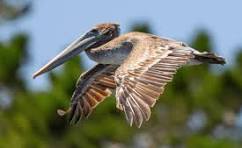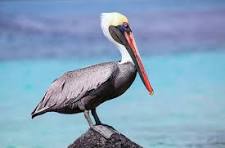How Pelicans Fish: Dive Hunting, Cooperative Tactics, and Adaptations That Make Them Masterful Aquatic Predators in Challenging Environments
Pelicans are fascinating birds with unique fishing techniques that have evolved over millions of years to help them efficiently capture food in diverse aquatic environments. With their large wingspans, distinctive bills, and graceful flight patterns, pelicans are a marvel of nature’s design, perfectly adapted for life as formidable fish hunters. The most commonly observed species of pelicans, such as the brown pelican (Pelecanus occidentalis) and the American white pelican (Pelecanus erythrorhynchos), showcase a range of fishing behaviors that highlight their adaptability and intelligence. This post will explore the strategies, behaviors, and physiological adaptations that enable pelicans to fish effectively. As you explore the beaches in the U.S Virgin Islands, take a moment to watch these fascinating birds as they fish for their meals.

Pelican in flight
1. Hunting Strategy: Diving vs. Cooperative Fishing
Pelicans typically employ one of two primary fishing techniques: plunge-diving and cooperative fishing. The brown pelican, a coastal species found along the shores of North and South America, is a skilled plunge diver. This bird relies on high-altitude dives to catch fish swimming near the surface of the water. When a brown pelican spots a potential target from the air, it will soar high, often reaching heights of up to 60 feet, and then fold its wings back before diving headfirst into the water. The impact of the dive is powerful, but the pelican’s body is uniquely adapted to withstand this force. Its skull and neck are reinforced to absorb the shock, and its nostrils are closed to prevent water from entering during the plunge. The bird’s eyes are protected by a nictitating membrane, which acts like a transparent third eyelid, shielding the eyes from water and debris while maintaining visibility underwater.
The brown pelican’s iconic dive is not merely a freefall. It is a calculated maneuver aimed at disorienting or stunning fish, making them easier to catch. As the pelican plunges into the water, it opens its large bill and extends its throat pouch to scoop up both water and fish. Once the pelican resurfaces, it drains the water from its bill before swallowing the fish. This entire process occurs within seconds, demonstrating the bird’s speed and agility. The brown pelican’s plunge-diving technique is particularly effective in coastal areas, where schools of fish often swim near the surface, providing ample opportunities for hunting.
In contrast, the American white pelican, which inhabits freshwater lakes and marshes across North America, uses a different approach to fishing. Rather than diving, this species practices cooperative fishing, working in groups to herd fish into shallow waters. American white pelicans often form a line or a semi-circle on the water’s surface and use their large wings to flap and create disturbances, driving fish toward the shore or into tight clusters. Once the fish are cornered, each pelican dips its bill into the water to scoop up its prey. This method allows the group to catch a large number of fish with relatively little effort. Cooperative fishing showcases the pelican’s social nature and demonstrates a level of group coordination and communication not commonly seen in other bird species.
2. Adaptations for Fishing: Anatomy and Physiology
Pelicans possess several anatomical and physiological adaptations that make them highly effective fishers. One of the most distinctive features of a pelican is its elongated bill, which can measure up to 18 inches in length, and the expandable throat pouch, or gular pouch, that hangs beneath it. This pouch is the pelican’s most crucial tool for catching fish. It is made of highly elastic skin that can stretch to hold up to three gallons of water, along with any captured fish. When a pelican catches prey, it uses its bill to scoop up fish and water simultaneously. It then contracts the muscles around the pouch to expel the water, while retaining the fish, which are then swallowed whole.
Another critical adaptation is the pelican’s specialized neck vertebrae, which are unique among birds. These vertebrae are designed to absorb the shock of impact when a pelican hits the water during a dive. This adaptation prevents injuries that could otherwise occur from the high-speed collision with the water’s surface. In addition, the pelican’s feathers are densely packed and coated with a waterproof oil produced by the bird’s uropygial gland, located near the base of the tail. This oil ensures that the pelican’s feathers remain dry, reducing drag and buoyancy when diving or swimming.
Pelicans also have exceptional eyesight, which is essential for spotting fish from great heights or through the glare of the water’s surface. Their eyes are positioned toward the front of their heads, providing binocular vision that enables them to accurately judge distances, a crucial skill when diving or targeting fish. The nictitating membrane, mentioned earlier, further enhances their vision by protecting their eyes underwater, allowing them to keep their eyes open and focused during a dive.
3. Feeding Behavior and Diet
While pelicans primarily feed on fish, their diet can be surprisingly varied, depending on the availability of prey in their environment. Common fish species targeted by pelicans include mullet, anchovies, sardines, and menhaden, which are typically found in large schools near the water’s surface. The size of the fish consumed varies, but pelicans generally prefer fish that are between six and twelve inches long — small enough to be swallowed whole but large enough to provide sufficient nutrition.
Pelicans are opportunistic feeders and may occasionally consume other marine life, such as crustaceans or amphibians, particularly in environments where fish are scarce. Juvenile pelicans, still developing their fishing skills, often rely on a diet of small fish and are sometimes observed scavenging around fishing boats or piers, where they can more easily obtain food. Additionally, pelicans may follow fishing vessels to feed on bycatch or discarded fish, demonstrating their adaptability and resourcefulness.
4. Environmental Factors Affecting Pelican Fishing
The fishing success of pelicans is influenced by a variety of environmental factors, including water clarity, temperature, and fish abundance. Clear water allows pelicans to spot their prey more easily, while murky or turbid water can make hunting more challenging. Seasonal changes in fish populations, due to breeding cycles or migration, also affect the availability of prey. For example, during the summer months, when fish tend to congregate in shallower waters, pelicans may find hunting easier and more productive.
Weather conditions play a crucial role in pelican fishing behavior as well. Wind patterns, for instance, can impact the availability of fish near the surface, as strong winds create surface disturbances that may drive fish into deeper waters, making them less accessible to pelicans. Conversely, calm weather may result in more surface activity among fish, providing pelicans with better opportunities to hunt.

Pelican resting in between fishing
5. Challenges and Threats to Pelican Fishing
While pelicans are highly adapted to their fishing lifestyle, they face several challenges that can impact their ability to catch food. Human activities, such as overfishing, pollution, and habitat destruction, can significantly reduce fish populations, making it more difficult for pelicans to find adequate prey. In particular, overfishing of small, schooling fish like anchovies and sardines can have a direct impact on pelican populations, as these species are a primary food source for many pelican species.
Additionally, pollution, especially oil spills, poses a severe threat to pelicans. Oil can coat their feathers, reducing their waterproofing and insulating properties, which can lead to hypothermia, drowning, or reduced flight capability. Ingested oil, either directly or through contaminated prey, can cause internal damage and poisoning. Climate change also presents a long-term challenge, as rising sea levels and changing weather patterns may alter fish distributions and the availability of suitable habitats for pelicans.
In conclusion, Pelicans are remarkable birds with diverse and efficient fishing techniques that allow them to thrive in a variety of aquatic environments. From the dramatic plunge dives of the brown pelican to the cooperative fishing of the American white pelican, these birds demonstrate a combination of physical adaptations and learned behaviors that make them highly successful hunters. However, their survival depends not only on their natural skills but also on the health and sustainability of their ecosystems. Understanding how pelicans fish for food offers insights into their behavior, adaptations, and the broader ecological challenges they face in a rapidly changing world.
- Posted in:
- Bird Watching
- Marine Ecology
- Wildlife Behavior
